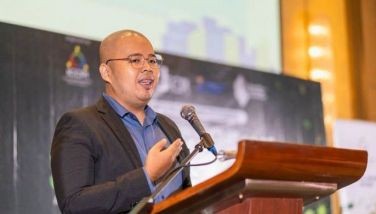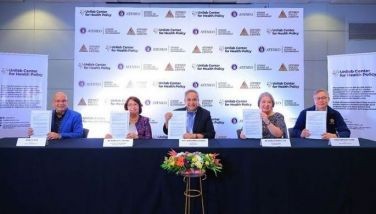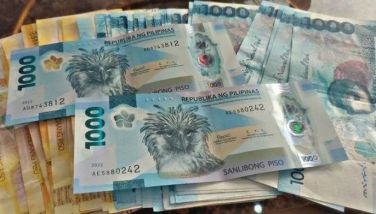Putting numbers to P-Noy's good news

I just had a long talk with DTI undersecretary Tito Panlilio and he tried to put more numbers to P-Noy’s good news about the economy. Some numbers are goals they have set for themselves and have yet to meet. Other numbers show the reported good feeling of the business community with P-Noy is actually true.
The usec tried to give the impression that this administration is starting to get some work done, even if slower than required to meet their goals. But even this is good news and somehow, P-Noy’s information people are doing a good job of keeping the good news under wraps. That makes P-Noy look silly for castigating media for not accentuating the good news P-Noy’s own people are keeping as state secrets.
I came out of that three hour conversation with usec Tito convinced that at least for DTI, they are working towards some quantifiable goals… that there is a game plan. A quantifiable deliverable usec Tito mentioned is moving up the value of our GDP from the current level of about $225 billion to as much as $450 billion by 2016.
Usec Tito conceded that means they must deliver a consistent growth rate of about seven percent, which however isn’t likely to make a real dent on poverty. They are also dreaming of 10-percent growth, which is probably a tall order though not impossible.
Usec Tito also said they are working to bring down the unemployment rate to the three percent level by 2016. He must have seen me roll my eyes so he defensively intoned this goal is doable by focusing on SMEs as the backbone for job creation.
He said that last year, around 200,000 new businesses were registered by the DTI, mostly SMEs. In the first quarter of this year, 150,000 have already registered and they are looking at some 450,000 total registrants by year-end.
If these SMEs hire just two or three employees each, over a million new jobs would be created. That’s on top of employment created by foreign direct investments (FDI). He thinks FDIs will hit $5 billion this year by the reckoning of the Board of Investments (BOI). The BSP only reported FDIs of $1.8 billion last year.
There is a difference in the FDI numbers of the BOI and the BSP. The BOI reports the value of all FDI applications they have approved. The BSP reports only those FDIs that register with them. Some BOI approved projects don’t materialize. But on the other hand, some approved projects that are implemented are not reported to the BSP.
Usec Tito said many investors do not find the need to register with the BSP because they trust our forex situation. A BSP registration would give them priority in the allocation of forex if our forex situation becomes precarious and that isn’t the case now. Our $76-billion gross international reserve is enough to reassure investors of stability.
I asked usec Tito how he felt about the strong peso and like most of us he had mixed feelings about it. But he said he is worried it may go beyond the P42 to the dollar optimum level which will hurt not just OFW families but the exporters and the BPOs as well. The P41 level is breakeven already, he said, and P39 will prove catastrophic to the BPOs whose contracts are in dollar terms but expenses in peso terms.
The BPO industry roadmap for the medium-term (2011-2016) estimates growth in revenues to rise to between $15 billion to $25 billion or equivalent to 10 percent of the global market. The industry also sees its workforce hitting 1.3 million by 2016. The Philippines cannot afford to risk losing the BPO industry because of a strong peso.
Usec Tito also offered more proof that foreign investors are really interested in the Philippines these days. He said the number of in-bound trade missions (defined as a group of five or more investors from different companies) have increased from 18 last year to 28 just in the first half of this year. Interests expressed by these potential investors were across a cross section of the Philippine economy, the usec added.
The usec gave me a list of DTI initiatives in the manufacturing sector and the development of SMEs is being given the strongest push. He said they look at the SMEs not only for strong employment generation but also for producing the greatest impact in reducing poverty in the countryside.
Helping the SMEs includes a P700-million program that would buy and install shared facilities for SME clusters. For instance, in Marikina, a machine to test leather was bought to assist the shoemakers.
In other areas where dairy is a popular enterprise, pasteurization machinery housed in a local university are being acquired. The SMEs using these facilities only need to pay operational costs and don’t have to worry about depreciating fairly expensive capital equipment.
The DTI usec conceded that their efforts could be frustrated by failure to make our cost of electricity competitive with the region. The possibility of Luzon-wide power shortages next year is also in his list of nightmares.
Also among the problems they hope to deal with is smuggling. Smugglers have killed and is still killing local industries. On the other hand, usec Tito thinks they are making progress in reducing the cost of doing business, as in eliminating corruption and red tape specially at the LGU level.
Asked if he thinks we are still competitive in the garments industry, the usec said we still are. Reacting to the complaint of high labor costs aired in this column by garments industry pioneer Bernadine Siy, the usec said relocating to the least developed provinces should be a viable strategy to lower labor costs in addition to BOI incentives.
The usec said that PEZA can also establish industrial zones dedicated to domestic enterprises. He urged the garments industry to explore with PEZA the possibility of trying innovative labor pricing options in special zones located in the least developed provinces.
We talked about other plans and programs for other manufacturing industries which we will write about in future columns. Suffice it to say now that at the very least, they have the right intentions at DTI, even if the things they are doing are apparently in stealth mode.
But as in everything else, DTI and BOI will have to deliver on a lot of hopes and dreams by 2016. Hopefully, they don’t run out of time.
Helmets
Speaking of DTI, here is a reader reaction to a recent DTI requirement for the registration of motorcycle helmets.
I heard a disturbing story today from one of my staff members, and I thought that this should be corrected immediately for the public’s safety.
The government implemented a policy where all motorcycle riders must wear helmets. Very good. It then stated that all helmets must have an ICC sticker, certifying that it meets a minimum safety standard. Again, very good.
Next, government requires ALL motorcycle riders to go to some office (not sure if it is DTI) and have each helmet checked and registered. God knows why these bureaucrats love making life so aggravating for everyone, but there you go.
The disturbing part is that when one goes to have their helmet checked, the inspector drops the helmet to the floor to see if it cracks. Now, I am an ex-race driver and we were always told that if ever our helmets suffered a strong impact, or was even just dropped, we must replace it and never use it again.
The purpose of a helmet is to absorb and dissipate as much energy as possible during an impact. And it can only do that once. After that, it must be discarded. When dropping a helmet to the floor, cracks may not be visible to the naked eye. But under a microscope, hairline cracks may be seen.
Thus, the helmet has already done its job. If a rider were to use this same helmet again and encounter an accident, the helmet could very well crumble leaving the rider’s head very vulnerable to serious injury.
I can only surmise that these government inspectors have the public’s interests at heart. Unfortunately, they do not know what they are doing and are therefore exposing these riders to unnecessary dangers. Perhaps, like in many, many, matters, our government officials and their subordinates should do their homework and understand the issues first before just acting and endangering us citizens.
Diplomacy
Our DFA hot shots have apparently forgotten the art of diplomacy. Here are a couple of reminders of what it is:
Diplomacy: the art of letting someone have your way.
Diplomacy is the art of saying good doggie while looking for a bigger stick.
Boo Chanco’s e-mail address is bchanco@gmail.com. Follow him on Twitter @boochanco
- Latest
- Trending




























